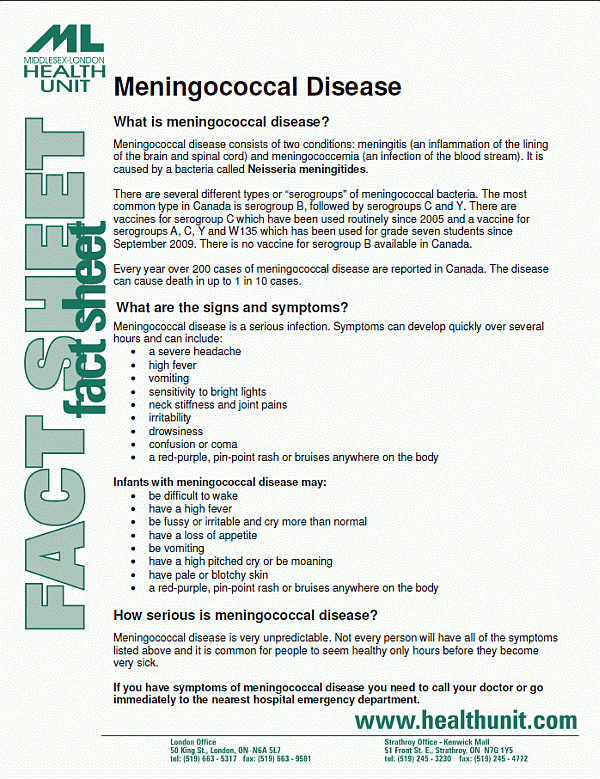What are the signs and symptoms?
Meningococcal disease is a serious infection. Symptoms can develop quickly over several hours and can include:
- a severe headache
- high fever
- vomiting
- sensitivity to bright lights
- neck stiffness and joint pains
- irritability
- drowsiness
- confusion or coma
- a red-purple, pin-point rash or bruises anywhere on the body
Infants with meningococcal disease may:
- be difficult to wake
- have a high fever
- be fussy or irritable and cry more than normal
- have a loss of appetite
- be vomiting
- have a high pitched cry or be moaning
- have pale or blotchy skin
- have a red-purple, pin-point rash or bruises anywhere on the body
Back to top
How serious is meningococcal disease?
Meningococcal disease is very unpredictable. Not every person will have all of the symptoms listed above and it is common for people to seem healthy only hours before they become very sick.
If you have symptoms of meningococcal disease you need to call your doctor or go immediately to the nearest hospital emergency department.
Back to top
How do I prevent the spread of meningococcal disease?
The germ that causes meningococcal disease lives naturally in the back of the nose and throat in about 1 in 10 people. Most people will never get sick with meningococcal disease. Household contacts, those who share sleeping arrangements and children in daycare with sick person are at increased risk of infection.
Meningococcal disease is spread through the saliva (spit) of an infected person when sharing items like:
- cigarettes, lipstick
- food or beverages: unwashed cups or utensils, water bottles, cans, drinking straws
- toothbrushes, mouth guards
- unwashed musical instruments with mouthpieces
- kissing on the mouth
To prevent the spread of meningococcal disease, it is important not to share anything that has been in someone else’s mouth. Hand washing and covering your mouth when coughing or sneezing are also important prevention measures.
Back to top
Who is considered a close contact?
Close contacts of someone who is sick with meningococcal disease are at increased risk for getting sick themselves. A person is a close contact if they are:
- Household members of the sick person;
- Those who share sleeping arrangements with the sick person or kissed them on the mouth;
- Children in the same day care because they tend to put objects in their mouths; staff members are also considered close contacts;
- Airline passengers sitting immediately on either side of the sick person (but not across the aisle) when the total time spent on board the plane was at least eight hours;
- Those who shared objects with the sick person including drinks, cigarettes, unwashed water bottles, unwashed dishes and utensils, lipstick, toothbrushes, unwashed musical instruments mouthpieces, mouth guards, food or drinks;
- Health care workers who have had unprotected contact with the mouth or nose secretions of an infected patient while intubating, resuscitating or closely examining the mouth or throat.
Classroom, workplace and social contacts are not considered close contacts unless they have been involved in any of the above activities with the sick person.
Back to top
What do I do if I am a close contact?
Antibiotics are given to prevent meningococcal disease in close contacts. Your doctor may prescribe one of the following antibiotics:
- Ciprofloxacin is given by mouth as a single dose. It is used in adults 18 years of age and older. It should not be used before puberty, in pregnant women or women who are breast feeding.
- Rifampin is given by mouth twice a day for two days. It can cause urine, saliva and tears to turn a reddish-orange colour. Contact lenses should not be worn while you are taking rifampin. This drug can also make birth control pills less effective. If you are on "the pill" you should use a backup method such as condoms, until starting the next package of pills. Pregnant women, breastfeeding mothers, and those with jaundice should not take rifampin.
- Ceftriaxone is given as a single intramuscular injection. This is the drug of choice if you are pregnant.
Close contacts of a person with meningococcal disease are offered vaccination if the sick person has a type of meningococcal disease that can be prevented by vaccination.
Back to top
Should I be vaccinated against meningococcal disease?
You may be offered free meningococcal vaccination if you are a close contact of a person with serotype A,B,C,Y,W-135 meningococcal disease.
Since 2005, children one year of age, adolescents in grade seven, and high school students have been routinely vaccinated against serogroup C meningococcal disease. In September, 2009, protection for adolescents in grade seven was expanded to include meningococcal serogroups A, C, Y and W135.
Vaccination against serogroups A, C, Y and W135 should be provided to people with no spleen or whose spleen does not work properly, travelers to certain countries including those going to the Hajj in Saudi Arabia, some laboratory workers, members of the military and some individuals who have problems with their immune system.
Vaccination to protect against serogroup B meningococcal disease has been licensed for use in people two months to 17 years of age and is available by prescription. However, it is free for people between two months and 17 years of age who have a high risk condition such as functional or anatomic asplenia, complement, properdin, factor D or primary antibody deficiencies; cochlear implant recipients; acquired complement deficiencies and HIV.
Back to top
